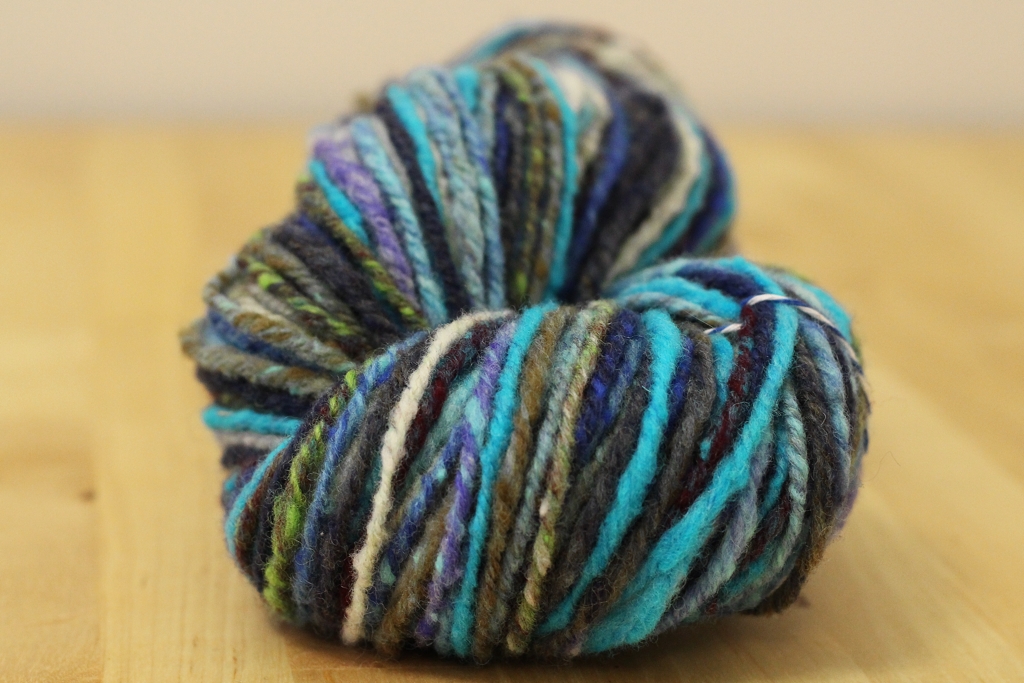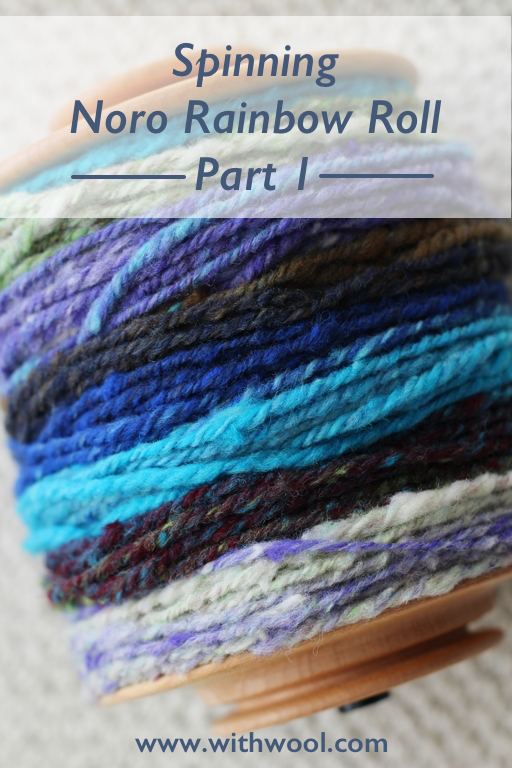Spinning Noro Rainbow Roll Part 2
/When last we left our intrepid handspun, it was still on the bobbin and plotting it’s escape… I’m pretty sure the grand plan was to look really pretty so that I’d have to skein it up. Well, it worked because I couldn’t resist anymore. I used a swift to wind the skein and popped it off to get a better look at the yarn. The neps and clumps of wool, which has been the determining factor for how the yarn was spun , were still visible but didn’t stick out like a sore thumb. In fact, the neps along with some uneven tension they created during plying gave the handspun a bit of rustic charm. The chain-plied single was both distinct and rather plump. Plus, It didn’t look all that different from a yarn drafted with a more conventional method.
I quickly measured the wraps per inch, and dunked it into a cool bath with Eucalan for about 20 minutes. The water had a slight blue tinge, but the yarn didn’t leave any dye on the white towel I used to squish out extra water. Then I snapped the yarn across my arms a few times to even out the twist. Those steps are all part of my usual yarn finishing routine. On a lark, I decided to also give the yarn a few good thwacks against the shower wall with the thought that it would make the neps less visible. Then I hung the yarn to dry overnight.
There’s a reason I only sometimes “thwack” handspun, and this yarn is a perfect example why. Thwacking definitely made the neps less visible but it also changed the yarn’s surface. The distinct “plies” relaxed which means that a lot of the finer details were lost. The bloom also gave the yarn a bit of a halo - great for hiding neps but at the cost of making the yarn a little prickly. I’m not particularly sensitive to prickle, so I could still wear this yarn next my neck, but it wouldn’t be my first choice for a cowl. The yarn, and the roving it used to be, was definitely softer before it got a good thwacking. If you like the character neps can add to a yarn, just snap the yarn to even out the twist and hang it up to dry.
There was one other change to the yarn after finishing, wraps per inch. Before getting a bath, the WPI averaged 7-8 which put into into the aran-bulky range. After washing, the yarn was definitely a bulky weight at 7 WPI. Pre-bath measurements also told me that I had about 158 yards but I’m sure there’s less now that the yarn has plumped up. If I’m doing my math correctly, that would mean I turned 294 yards of pencil roving into a 474 yard single.
Since we’re talking about a chain-plied yarn, here’s where two of the chains linked together. This bulky change is actually an exception in the skein because I was able to find it. In spite of the thick and thin nature of the single, the joins between links are generally invisible. It probably helps that I made fairly large chains, usually 18” or longer.
The other good thing about making long chains while chain-plying a single with a distinct stripe pattern is that it helps colors shift from one to the next without muddying them. While most roving is one long length that’s been dyed, Rainbow Roll is a combination of pre-dyed wool carded in stripes. Check out these photos of Noro’s yarn being made to see what I mean. Sometimes the color is solid and other times a heather where colors overlap. Chain-plying helped blend those two different kinds of color.
I got so caught up in how to deal with neps, that I forgot to mention vegetable matter earlier. There was some VM, but not much and it was easy enough to pick out. I also noticed a small amount in the bottom of the sink when I took the yarn out of the bath. The roving definitely didn’t feel dirty while I was spinning it.
Now that I’ve got a fresh skein of handspun in the stash, what’s my verdict? Sometimes being stubborn is a good thing. Figuring out how turn a nep-filled roving into yarn without hating every second of spinning it became a puzzle I had to solve. I’m absolutely thrilled with the yarn Rainbow Roll became, but I know the process required to get there isn’t everyone’s cup of tea. It was frustrating before I found a solution and afterward the spinning never did go to autopilot. Nor was this the kind of project where I could do anything I wanted. The fiber called the shots 100% and completely changed my original plan. If you want autopilot spinning where you’re in control, pick something else and save the Rainbow Roll for knitting or weaving. Just don’t tug too hard. If you're up for some focused spinning, Rainbow Roll will certainly fit the bill.



























